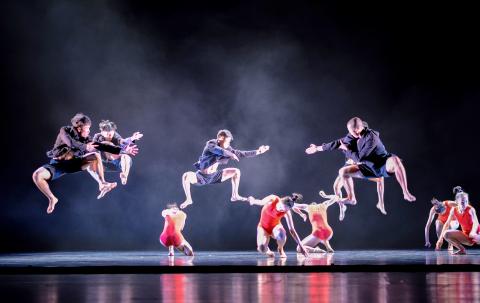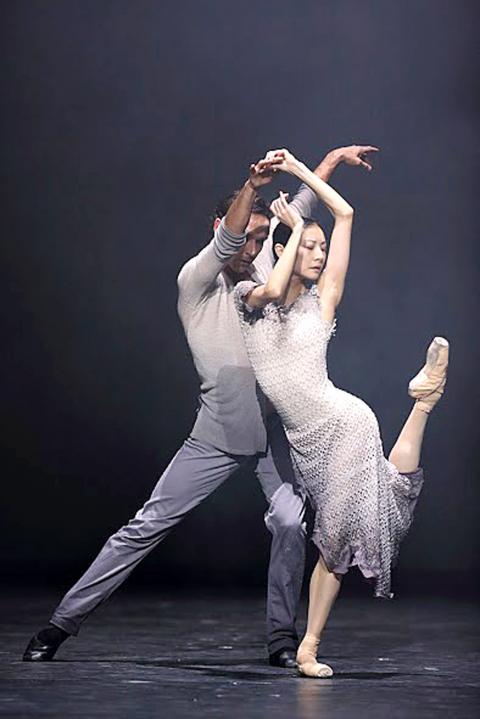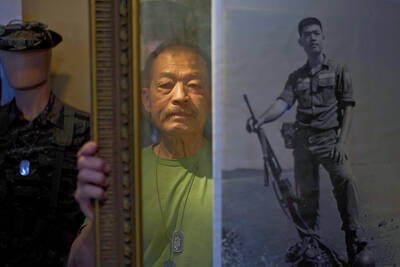Who knew that beneath the image of the cool, cerebral modern dance master beat the heart of a breakdance artist?
That was a lasting impression left by the opening night of the 2X2 program at the National Theater on Friday last week, produced by Fany-yi Sheu & Artists, that centered on Taiwan’s fabulous export, Sheu Fang-yi (許芳宜), and one of China’s claims to dance fame, Tan Yuanyuan (譚元元), the Shanghai-born principal dancer with the San Francisco Ballet.
The show combined parts of a program of dances by Christopher Wheeldon, Russell Maliphant and Taiwanese-born dancer-turned-choreographer Edwaard Liang (梁殷實). It included dance routines that Sheu and Tan had performed in Beijing in 2012, as well as Sadler’s Well Theatre in London last year. It also consisted of four works by Sheu, who has been honing her choreographic skills in recent years for the annual Vail International Dance Festival and elsewhere.

Photo Courtesy of Lativ
The Yilan County-born Sheu, who became a principal dancer with the Martha Graham Dance Company in New York and a renowned interpreter of the Graham technique, is a massive star in Taiwan’s dance constellation and a major inspiration for the nation’s young performers. Her rare appearances in Taiwan in recent years have usually resulted in sold-out shows, as was the case with her first production, Timeless, at the National Theater two years ago, which featured New York City Ballet dancers Wendy Whelan, Craig Hall and Tyler Angle, and British dancer/choreographer Akram Khan.
Tickets for last weekend’s three performances of 2X2 sold out almost two months in advance.
Taipei dance lovers were also eager for another chance to see Tan, who dazzled audiences with her first appearance on the National Theater’s stage in the 2008 International Ballet Star Gala.

Photo Courtesy of Sam Tsao
The highlights of the program were the four duets: Liang’s Finding Light; Sheu’s Anywhere on this Road, Wheeldon’s After the Rain and Maliphant’s 2X2.
Liang’s piece, created for Tan and set to Vivaldi’s Concerto in B Major, is a quietly sensual duet that emphasizes the ballerina’s amazing long legs and delicacy, and fellow San Francisco Ballet principal dancer Damian Smith’s sturdy support. The pair danced with the easy familiarity of a long-term couple, her apparent fragility highlighted by the gentle lifts around his shoulders. The muted grey-purple palette of the lighting and costumes reinforced the image of softness and affection.
The pace of the show took a quick jump to urban modernity with Anywhere on this Road, which was commissioned by the Vail International Dance Festival last year. Dancing to the song of the same name by Lhasa de Sela, Sheu and Ron “Prime Tyme” Myles were a study in contrasts — in build and control — giving audiences a chance to compare a modern dancer’s isolationist techniques and footwork to that of a Memphis Jookin star.

Photo Courtesy of Wang Xiaojing
Memphis Jookin is a bouncy yet smooth footwork-focused street-dance style that originated in Memphis, Tennessee and highlights the dancer’s sliding abilities. Myles, who followed in the footsteps of his cousin, Charles “Lil’ Buck” Riley, is a prime proponent of the genre.
Both Sheu and Myles looked as if they were enjoying every single second of their dance-off — as was the audience.
In stark contrast was Sheu’s next appearance, partnered with Angle, in After the Rain, set to Arvo Part’s Tabula Rasa. It was a rare chance to see Sheu in a romantic, balletic role.
However, it is Maliphant’s 2009 duet for Sheu and Tan that lingers most in the mind, as did his solo component, 2X2, which Sylvie Guillem performed as part of her Push program at the National Theater in September. Both works are set to music by Andy Cowton that begin with sonar-like beeps and build to an explosion of pounding sound and both utilize Michael Hull’s skills to create darkly lit boxes of space for the dancers that turn their arms into glowing, golden shards of light.
2X2 emphasizes Tan’s slender angularity, keeping her upright in the back, while downstage Sheu is more grounded, often laying or kneeling on the floor as if bound by gravity. The emphasis is on the dancers’ upper body and arms, with their legs occasionally defining an arch within the small dark confines of their boxes of light. Their torsos ripple, their arms stretch out seemingly forever, wrists and fingers curling and uncurling with the delicateness of flower petals, while the increasingly rapid swirls of their arms turns them into human pinwheels. Sheu and Tan move independently, but with tight precision, sometimes in sync, sometimes just a beat off, until in the end they become just blurs of speed and light.
I wished there had been another piece with the two of them together. Sheu and Fan are such a study in contrasts — in bodies, training and technique — and powerhouses on the stage, and they clearly enjoy working together. It is fascinating to watch them interact.
The other three pieces on the program suffered in comparison to the duets.
Talk to Her, which was commissioned by the Vail International Dance Festival this year, is a short solo that Sheu created for young New York City Ballet soloist Lauren Lovetee to music by Max Richter. It highlights the ballerina’s tiny frame and air of vulnerability, but it seemed neither a stretch for her or for Sheu’s talents.
Le Celeste (許芳宜), which opened the show, is a simple group piece for eight women and two men set to a score by Steve Reich. It highlighted the training that Sheu has put the young dancers she selected for this show through, but was hardly groundbreaking.
The longer Chinese Talk, set to an electronic score by Lin Giong (林強), features 10 women and six male dancers. It turned out to be a cacophony of dialogue, news reports and dance that mixed the exaggerated side-to-side steps of the Eight Generals figures of Taoist religious processions (performed by the men), with marionette-like marching or hip-swaying parades by the women, with some breakdancing moves thrown in for good measure.
Sheu said she was inspired by childhood memories and Chinese Talk, did have the chaotic feel that can often be modern city life in Taiwan, but it left me feeling as limp as the bodies that flopped on the stage as the curtain came down.
2X2 was a mixed program overall, but it was still a satisfying evening that left audiences hungry for more of Sheu — both as a dancer and as a choreographer. Hopefully, Taipei will not have to wait another two years for her next production. And maybe the National Theater can squeeze in an extra performance as well to pacify fans who missed out on this year’s performances.

When the South Vietnamese capital of Saigon fell to the North Vietnamese forces 50 years ago this week, it prompted a mass exodus of some 2 million people — hundreds of thousands fleeing perilously on small boats across open water to escape the communist regime. Many ultimately settled in Southern California’s Orange County in an area now known as “Little Saigon,” not far from Marine Corps Base Camp Pendleton, where the first refugees were airlifted upon reaching the US. The diaspora now also has significant populations in Virginia, Texas and Washington state, as well as in countries including France and Australia.

On April 17, Chinese Nationalist Party (KMT) Chairman Eric Chu (朱立倫) launched a bold campaign to revive and revitalize the KMT base by calling for an impromptu rally at the Taipei prosecutor’s offices to protest recent arrests of KMT recall campaigners over allegations of forgery and fraud involving signatures of dead voters. The protest had no time to apply for permits and was illegal, but that played into the sense of opposition grievance at alleged weaponization of the judiciary by the Democratic Progressive Party (DPP) to “annihilate” the opposition parties. Blamed for faltering recall campaigns and faced with a KMT chair

Article 2 of the Additional Articles of the Constitution of the Republic of China (中華民國憲法增修條文) stipulates that upon a vote of no confidence in the premier, the president can dissolve the legislature within 10 days. If the legislature is dissolved, a new legislative election must be held within 60 days, and the legislators’ terms will then be reckoned from that election. Two weeks ago Taipei Mayor Chiang Wan-an (蔣萬安) of the Chinese Nationalist Party (KMT) proposed that the legislature hold a vote of no confidence in the premier and dare the president to dissolve the legislature. The legislature is currently controlled

Dull functional structures dominate Taiwan’s cityscapes. But that’s slowly changing, thanks to talented architects and patrons with deep pockets. Since the start of the 21st century, the country has gained several alluring landmark buildings, including the two described below. NUNG CHAN MONASTERY Dharma Drum Mountain (法鼓山, DDM) is one of Taiwan’s most prominent religious organizations. Under the leadership of Buddhist Master Sheng Yen (聖嚴), who died in 2009, it developed into an international Buddhist foundation active in the spiritual, cultural and educational spheres. Since 2005, DDM’s principal base has been its sprawling hillside complex in New Taipei City’s Jinshan District (金山). But